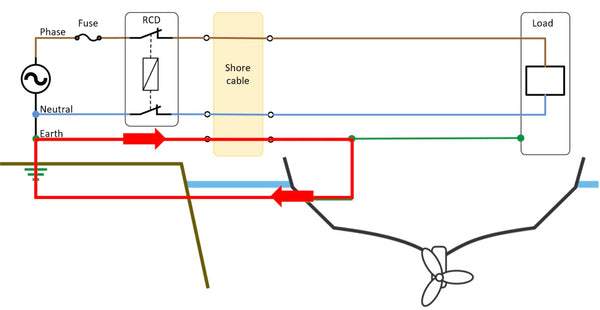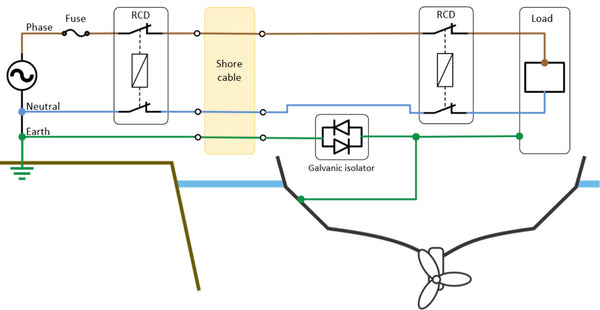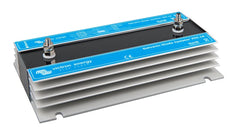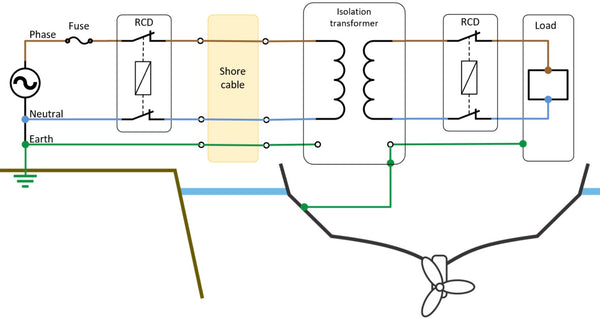Don't sink your boat! Galvanic corrosion
Source: adapted from Victron - Wiring Unlimited
Galvanic currents are DC (Direct Current) currents caused by the natural voltage difference between metals. If a boat with a metal hull is near the shore, a natural voltage difference of 0.1 - 1 Vdc exists between the hull and the water. This is not a problem, as long as there isn't a closed electric circuit. However, when shore power is connected to the boat, the shore earth is automatically connected to the boats hull and the electric circuit is complete (hull - water - shore - earth spike - earth wire - hull). This can lead to corrosion to the underwater metals of the boat, like the hull, propeller, and shaft.
Galvanic circuit (RCD = Residual Current Device)
In this circuit, the “weakest” metal will be the quickest to submit its molecules to keep the current going. If the hull of the ship is part of the galvanic circuit and the hull contains the weakest metal, the hull will start to corrode over time. There are known cases of ships having sunk due to galvanic corrosion. Aluminium hulls are notoriously susceptible to this kind of corrosion.
Galvanic corrosion can also exist between the different metals of the propeller, the motor, the hull and so on. As all these parts are connected to earth, additional small currents will run between them.
How to prevent galvanic corrosion?
To prevent corrosion in smaller circuits between metals on the boat, sacrificial anodes (also called galvanic anodes) are mounted. A sacrificial anode is a piece of metal which is 'weaker' than the metal around it. The anode is sacrificed in order to protect the other metals. Anodes are made of metal alloys like Aluminium, Zinc or Magnesium. There are different types of anodes depending on which metal it has to protect and whether the boat is sailing in salt or sweet water. It is important to check the anodes regularly for wear and replace them when necessary.
Sacrificial Anode
In shore power connections, a galvanic isolator or an isolation transformer can break the galvanic circuit, while keeping the shore earth connected to the hull for safety reasons.
The galvanic isolator prevents galvanic corrosion by blocking the low voltage currents that enter your boat through the shore power earth wire. The galvanic isolator is connected between the shore earth and the central boat earth point.
Circuits with Galvanic Isolator (RCD = Residual Current Device)
A Galvanic Isolator consists of two diodes that are anti-parallel-connected, and in this configuration conduct electricity in both directions, only when a threshold voltage of around 1.4 Vdc is reached. This threshold voltage is higher than the galvanic potential difference between the various metals, so there will be no galvanic current. The advantage of the galvanic isolator is its low weight and size, the disadvantage is that this unit relies on a good earth conductor.
Victron galvanic Isolator
A better solution to stop galvanic corrosion is the use of an isolation transformer. The transformer changes the incoming electricity into electromagnetism and then changes it back into electricity. As the input and output are completely isolated, it will break the electric circuit between star point - earth conductor - hull - water - star point, thus effectively blocking a galvanic current.
Circuits with Isolation Transformer (RCD = Residual Current Device)
Another feature of the isolation transformer is that electrically speaking it is an electricity source, fed by another electricity source. On the output side of the transformer one of the outgoing phases is connected to the hull, whereby creating a phase, neutral and earth, thus guaranteeing a correct functioning of an RCD, Residual Current Device. An isolation transformer will provide the same safety as a home installation, and it also isolates the circuits from other surrounding boats.
In addition, an Isolation Transformer can also modify the AC Voltage, e.g. when 230 Vac is needed when there is a 120 Vac shore supply, or vice versa.
Victron Isolation Transformer
Click to find more details on the Victron Galvanic Isolator or the Victron Isolation Transformer.
Click here to visit the SunStore Marine Products.
